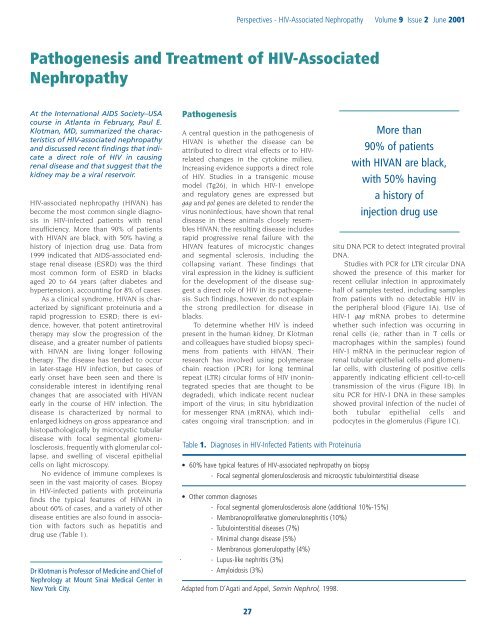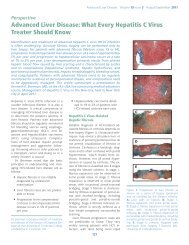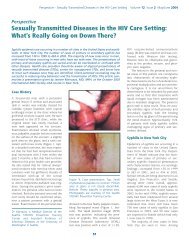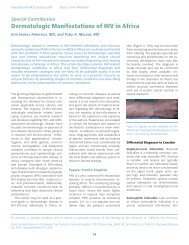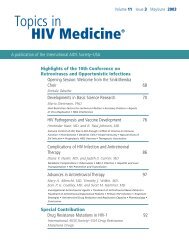Pathogenesis and Treatment of HIV-Associated Nephropathy
Pathogenesis and Treatment of HIV-Associated Nephropathy
Pathogenesis and Treatment of HIV-Associated Nephropathy
You also want an ePaper? Increase the reach of your titles
YUMPU automatically turns print PDFs into web optimized ePapers that Google loves.
Perspectives - <strong>HIV</strong>-<strong>Associated</strong> <strong>Nephropathy</strong> Volume 9 Issue 2 June 2001<br />
<strong>Pathogenesis</strong> <strong>and</strong> <strong>Treatment</strong> <strong>of</strong> <strong>HIV</strong>-<strong>Associated</strong><br />
<strong>Nephropathy</strong><br />
At the International AIDS Society–USA<br />
course in Atlanta in February, Paul E.<br />
Klotman, MD, summarized the characteristics<br />
<strong>of</strong> <strong>HIV</strong>-associated nephropathy<br />
<strong>and</strong> discussed recent findings that indicate<br />
a direct role <strong>of</strong> <strong>HIV</strong> in causing<br />
renal disease <strong>and</strong> that suggest that the<br />
kidney may be a viral reservoir.<br />
<strong>HIV</strong>-associated nephropathy (<strong>HIV</strong>AN) has<br />
become the most common single diagnosis<br />
in <strong>HIV</strong>-infected patients with renal<br />
insufficiency. More than 90% <strong>of</strong> patients<br />
with <strong>HIV</strong>AN are black, with 50% having a<br />
history <strong>of</strong> injection drug use. Data from<br />
1999 indicated that AIDS-associated endstage<br />
renal disease (ESRD) was the third<br />
most common form <strong>of</strong> ESRD in blacks<br />
aged 20 to 64 years (after diabetes <strong>and</strong><br />
hypertension), accounting for 8% <strong>of</strong> cases.<br />
As a clinical syndrome, <strong>HIV</strong>AN is characterized<br />
by significant proteinuria <strong>and</strong> a<br />
rapid progression to ESRD; there is evidence,<br />
however, that potent antiretroviral<br />
therapy may slow the progression <strong>of</strong> the<br />
disease, <strong>and</strong> a greater number <strong>of</strong> patients<br />
with <strong>HIV</strong>AN are living longer following<br />
therapy. The disease has tended to occur<br />
in later-stage <strong>HIV</strong> infection, but cases <strong>of</strong><br />
early onset have been seen <strong>and</strong> there is<br />
considerable interest in identifying renal<br />
changes that are associated with <strong>HIV</strong>AN<br />
early in the course <strong>of</strong> <strong>HIV</strong> infection. The<br />
disease is characterized by normal to<br />
enlarged kidneys on gross appearance <strong>and</strong><br />
histopathologically by microcystic tubular<br />
disease with focal segmental glomerulosclerosis,<br />
frequently with glomerular collapse,<br />
<strong>and</strong> swelling <strong>of</strong> visceral epithelial<br />
cells on light microscopy.<br />
No evidence <strong>of</strong> immune complexes is<br />
seen in the vast majority <strong>of</strong> cases. Biopsy<br />
in <strong>HIV</strong>-infected patients with proteinuria<br />
finds the typical features <strong>of</strong> <strong>HIV</strong>AN in<br />
about 60% <strong>of</strong> cases, <strong>and</strong> a variety <strong>of</strong> other<br />
disease entities are also found in association<br />
with factors such as hepatitis <strong>and</strong><br />
drug use (Table 1).<br />
Dr Klotman is Pr<strong>of</strong>essor <strong>of</strong> Medicine <strong>and</strong> Chief <strong>of</strong><br />
Nephrology at Mount Sinai Medical Center in<br />
New York City.<br />
<strong>Pathogenesis</strong><br />
A central question in the pathogenesis <strong>of</strong><br />
<strong>HIV</strong>AN is whether the disease can be<br />
attributed to direct viral effects or to <strong>HIV</strong>related<br />
changes in the cytokine milieu.<br />
Increasing evidence supports a direct role<br />
<strong>of</strong> <strong>HIV</strong>. Studies in a transgenic mouse<br />
model (Tg26), in which <strong>HIV</strong>-1 envelope<br />
<strong>and</strong> regulatory genes are expressed but<br />
gag <strong>and</strong> pol genes are deleted to render the<br />
virus noninfectious, have shown that renal<br />
disease in these animals closely resembles<br />
<strong>HIV</strong>AN; the resulting disease includes<br />
rapid progressive renal failure with the<br />
<strong>HIV</strong>AN features <strong>of</strong> microcystic changes<br />
<strong>and</strong> segmental sclerosis, including the<br />
collapsing variant. These findings that<br />
viral expression in the kidney is sufficient<br />
for the development <strong>of</strong> the disease suggest<br />
a direct role <strong>of</strong> <strong>HIV</strong> in its pathogenesis.<br />
Such findings, however, do not explain<br />
the strong predilection for disease in<br />
blacks.<br />
To determine whether <strong>HIV</strong> is indeed<br />
present in the human kidney, Dr Klotman<br />
<strong>and</strong> colleagues have studied biopsy specimens<br />
from patients with <strong>HIV</strong>AN. Their<br />
research has involved using polymerase<br />
chain reaction (PCR) for long terminal<br />
repeat (LTR) circular forms <strong>of</strong> <strong>HIV</strong> (nonintegrated<br />
species that are thought to be<br />
degraded), which indicate recent nuclear<br />
import <strong>of</strong> the virus; in situ hybridization<br />
for messenger RNA (mRNA), which indicates<br />
ongoing viral transcription; <strong>and</strong> in<br />
Table 1. Diagnoses in <strong>HIV</strong>-Infected Patients with Proteinuria<br />
situ DNA PCR to detect integrated proviral<br />
DNA.<br />
Studies with PCR for LTR circular DNA<br />
showed the presence <strong>of</strong> this marker for<br />
recent cellular infection in approximately<br />
half <strong>of</strong> samples tested, including samples<br />
from patients with no detectable <strong>HIV</strong> in<br />
the peripheral blood (Figure 1A). Use <strong>of</strong><br />
<strong>HIV</strong>-1 gag mRNA probes to determine<br />
whether such infection was occurring in<br />
renal cells (ie, rather than in T cells or<br />
macrophages within the samples) found<br />
<strong>HIV</strong>-1 mRNA in the perinuclear region <strong>of</strong><br />
renal tubular epithelial cells <strong>and</strong> glomerular<br />
cells, with clustering <strong>of</strong> positive cells<br />
apparently indicating efficient cell-to-cell<br />
transmission <strong>of</strong> the virus (Figure 1B). In<br />
situ PCR for <strong>HIV</strong>-1 DNA in these samples<br />
showed proviral infection <strong>of</strong> the nuclei <strong>of</strong><br />
both tubular epithelial cells <strong>and</strong><br />
podocytes in the glomerulus (Figure 1C).<br />
• 60% have typical features <strong>of</strong> <strong>HIV</strong>-associated nephropathy on biopsy<br />
- Focal segmental glomerulosclerosis <strong>and</strong> microcystic tubulointerstitial disease<br />
• Other common diagnoses<br />
- Focal segmental glomerulosclerosis alone (additional 10%-15%)<br />
- Membranoproliferative glomerulonephritis (10%)<br />
- Tubulointerstitial diseases (7%)<br />
- Minimal change disease (5%)<br />
- Membranous glomerulopathy (4%)<br />
- Lupus-like nephritis (3%)<br />
- Amyloidosis (3%)<br />
Adapted from D’Agati <strong>and</strong> Appel, Semin Nephrol, 1998.<br />
More than<br />
90% <strong>of</strong> patients<br />
with <strong>HIV</strong>AN are black,<br />
with 50% having<br />
a history <strong>of</strong><br />
injection drug use<br />
27
International AIDS Society–USA<br />
Topics in <strong>HIV</strong> Medicine<br />
A.<br />
B.<br />
C.<br />
Figure 1. Findings in renal biopsies in patients with <strong>HIV</strong>-associated nephropathy: (A) long terminal repeat<br />
circular DNA; (B) <strong>HIV</strong> messenger RNA; <strong>and</strong> (C) in situ polymerase chain reaction for <strong>HIV</strong> DNA. Adapted from<br />
Bruggeman et al, J Am Soc Nephrol, 2000.<br />
In subsequent studies, laser capture<br />
microscopy has been used to isolate renal<br />
epithelial cells shown to have integrated<br />
virus by in situ PCR to permit amplification<br />
<strong>of</strong> viral envelope V3 loop genetic<br />
sequences. These studies have found that<br />
the genetic variants <strong>of</strong> the virus in the kidney<br />
are distinct from the genetic variants<br />
in the peripheral blood <strong>of</strong> the same<br />
patient. This evolutionary divergence within<br />
patients suggests the presence <strong>of</strong> different<br />
selective pressures within the kidney.<br />
The results <strong>of</strong> studies that have used<br />
markers for cell differentiation <strong>and</strong> proliferation<br />
suggest that viral infection in renal<br />
cells is associated with a loss <strong>of</strong> differentiation<br />
<strong>and</strong> an increased proliferation <strong>of</strong><br />
podocytes <strong>and</strong> tubular epithelial cells. In<br />
summary, these studies have shown the<br />
presence <strong>of</strong> active viral replication in the<br />
renal cells <strong>of</strong> patients with <strong>HIV</strong>AN, <strong>and</strong> the<br />
finding <strong>of</strong> viral genetic material in samples<br />
from patients with no detectable <strong>HIV</strong> RNA<br />
in the peripheral blood at least suggests<br />
that the kidney could be a reservoir for<br />
<strong>HIV</strong>.<br />
<strong>Treatment</strong><br />
No st<strong>and</strong>ard therapy for <strong>HIV</strong>AN has been<br />
developed, but there is evidence that<br />
potent antiretroviral therapy has a beneficial<br />
effect on disease progression.<br />
Angiotensin-converting enzyme inhibitors<br />
are sometimes used in patients with<br />
<strong>HIV</strong>AN, but their effects have not been<br />
evaluated in controlled studies. Steroids<br />
have also been reported to be <strong>of</strong> benefit in<br />
some cases, but the rationale for using<br />
them in a disease that is not immune complex-mediated<br />
is not clear.<br />
The effects <strong>of</strong> potent antiretroviral therapy<br />
on <strong>HIV</strong>AN have yet to be examined in<br />
a controlled study; protocols for investigating<br />
this are currently being reviewed by<br />
the AIDS Clinical Trials Group. In the<br />
absence <strong>of</strong> data from controlled trials, Dr<br />
Klotman's group has generated a mathematical<br />
model for assessing the impact<br />
that potent therapy may have had on the<br />
increase in prevalence <strong>of</strong> ESRD in <strong>HIV</strong>infected<br />
black patients. In brief, this model<br />
shows that the decrease in the prevalence<br />
<strong>of</strong> ESRD that can be attributed to <strong>HIV</strong>AN<br />
since 1995 can be explained by the introduction<br />
<strong>of</strong> potent antiretroviral therapy.<br />
The best fit <strong>of</strong> the existing data demonstrates<br />
that potent therapy has had an<br />
estimated 28% efficacy in reducing the<br />
increases in the number <strong>of</strong> <strong>HIV</strong>-infected<br />
black patients with ESRD. This model also<br />
predicts that, in the absence <strong>of</strong> drug treatment<br />
with 100% efficacy <strong>and</strong> with increases<br />
expected in the pool <strong>of</strong> patients at risk<br />
for developing <strong>HIV</strong>AN (ie, black patients<br />
who are <strong>HIV</strong>-seropositive or living with<br />
AIDS), the size <strong>of</strong> the population <strong>of</strong> <strong>HIV</strong>infected<br />
patients with ESRD will continue<br />
to increase.<br />
Anecdotal evidence <strong>of</strong> a beneficial<br />
effect <strong>of</strong> potent antiretroviral therapy on<br />
very early onset <strong>HIV</strong>AN comes from the<br />
recent experience <strong>of</strong> Dr Klotman <strong>and</strong> colleagues<br />
in a patient who presented with<br />
ESRD during acute <strong>HIV</strong> seroconversion.<br />
Biopsy performed when the patient was<br />
about to undergo dialysis showed classic<br />
features <strong>of</strong> <strong>HIV</strong>AN, consisting <strong>of</strong> microcystic<br />
disease <strong>and</strong> focal segmental glomerulosclerosis.<br />
The patient was given aggres-<br />
28
Perspectives - <strong>HIV</strong>-<strong>Associated</strong> <strong>Nephropathy</strong> Volume 9 Issue 2 June 2001<br />
sive antiretroviral therapy, <strong>and</strong> plasma <strong>HIV</strong><br />
RNA level was suppressed to levels below<br />
detection limits. After 3 months the<br />
patient's renal failure had completely<br />
resolved. Repeated biopsy showed reversal<br />
<strong>of</strong> the microcystic changes that were<br />
present before potent antiretroviral therapy<br />
was initiated <strong>and</strong> resolution <strong>of</strong> collapsing<br />
glomerular disease with residual scarring.<br />
Collagen staining showed residual<br />
interstitial fibrosis, but it was markedly<br />
improved from the pretreatment condition.<br />
Assessing LTR circular viral DNA in<br />
biopsy samples found marked positivity<br />
before potent antiretroviral therapy, but<br />
not after. In addition, the resolution <strong>of</strong><br />
renal failure after potent therapy was<br />
accompanied by a restoration <strong>of</strong> podocyte<br />
differentiation (as indicated by increased<br />
synaptopodin staining) <strong>and</strong> normalized<br />
cell proliferation (as indicated by normalized<br />
Ki67 marker positivity). In situ<br />
hybridization for viral mRNA, however,<br />
showed that some (low) level <strong>of</strong> viral transcription<br />
was ongoing.<br />
Observations in this patient suggest<br />
both that renal damage due to active infection<br />
may be seen early in the course <strong>of</strong> <strong>HIV</strong><br />
infection <strong>and</strong> that potent antiretroviral<br />
therapy may have a beneficial effect on the<br />
course <strong>of</strong> <strong>HIV</strong>AN by stopping such damage,<br />
thus making structural <strong>and</strong> functional<br />
reconstitution possible. In addition, the<br />
finding <strong>of</strong> ongoing viral transcription in the<br />
absence <strong>of</strong> active cellular infection during<br />
potent antiretroviral therapy supports the<br />
hypothesis that the kidney may be a viral<br />
reservoir; it remains unclear, however,<br />
whether the kidney might be a source <strong>of</strong><br />
viral repopulation when the efficacy <strong>of</strong><br />
potent antiretroviral therapy in suppressing<br />
viral replication is reduced or when<br />
drug pressure is removed.<br />
Suggested Reading<br />
Alpers CE, McClure J, Bursten SL. Human<br />
mesangial cells are resistant to productive<br />
infection by multiple strains <strong>of</strong> human immunodeficiency<br />
virus types 1 <strong>and</strong> 2. Am J Kidney Dis.<br />
1992;19:126-130.<br />
Alpers CE, Tsai CC, Hudkins KL, et al. Focal segmental<br />
glomerulosclerosis in primates infected<br />
with a simian immunodeficiency virus. AIDS Res<br />
Hum Retroviruses. 1997;13:413-424.<br />
Barisoni L, Bruggeman LA, Mundel P, D'Agati<br />
VD, Klotman PE. <strong>HIV</strong>-1 induces renal epithelial<br />
dedifferentiation in a transgenic model <strong>of</strong> <strong>HIV</strong>associated<br />
nephropathy. Kidney Int. 2000;58:173-<br />
181.<br />
Barisoni L, Kriz W, Mundel P, D'Agati V. The dysregulated<br />
podocyte phenotype: a novel concept<br />
in the pathogenesis <strong>of</strong> collapsing idiopathic<br />
focal segmental glomerulosclerosis <strong>and</strong> <strong>HIV</strong>associated<br />
nephropathy. J Am Soc Nephrol.<br />
1999;10:51-61.<br />
Bruggeman LA, Dikman S, Meng C, Quaggin SE,<br />
C<strong>of</strong>fman TM, Klotman PE. <strong>Nephropathy</strong> in<br />
human immunodeficiency virus-1 transgenic<br />
mice is due to renal transgene expression. J Clin<br />
Invest. 1997;100:84-92.<br />
Bruggeman LA, Ross MD, Tanji N, et al. Renal<br />
epithelium is a previously unrecognized site <strong>of</strong><br />
<strong>HIV</strong>-1 infection. J Am Soc Nephrol. 2000;11:2079-<br />
2087.<br />
Burns GC, Paul SK, Toth IR, Sivak SL. Effect <strong>of</strong><br />
angiotensin-converting enzyme inhibition in<br />
<strong>HIV</strong>-associated nephropathy. J Am Soc Nephrol.<br />
1997;8:1140-1146.<br />
Cohen AH, Sun NC, Shapshak P, Imagawa DT.<br />
Demonstration <strong>of</strong> human immunodeficiency<br />
virus in renal epithelium in <strong>HIV</strong>-associated<br />
nephropathy. Mod Pathol. 1989;2:125-128.<br />
D'Agati V, Appel GB. <strong>HIV</strong> infection <strong>and</strong> the kidney.<br />
J Am Soc Nephrol. 1997;8:138-152.<br />
D'Agati V, Appel GB. Renal pathology <strong>of</strong> human<br />
immunodeficiency virus infection. Semin Nephrol.<br />
1998;18:406-421.<br />
Farkas-Szallasi T, Ferreira-Centeno A, Abraham<br />
AA, Garrett CT, Kimmel PL. Viral DNA in biopsy<br />
material from <strong>HIV</strong> infected patients with<br />
nephrotic syndrome. J Am Soc Nephrol.<br />
1991;2:306.<br />
Green DF, Resnick L, Bourgoignie JJ. <strong>HIV</strong> infects<br />
glomerular endothelial <strong>and</strong> mesangial but not<br />
epithelial cells in vitro. Kidney Int. 1992;41:956-<br />
960.<br />
Kimmel PL, Ferreira-Centeno A, Farkas-Szallasi<br />
T, Abraham AA, Garrett CT. Viral DNA in<br />
microdissected renal biopsy tissue from <strong>HIV</strong><br />
infected patients with nephrotic syndrome.<br />
Kidney Int. 1993;43:1347-1352.<br />
Klotman PE. <strong>HIV</strong>-associated nephropathy.<br />
Kidney Int. 1999;56:1161-1176.<br />
Kopp JB, Klotman ME, Adler SH, et al.<br />
Progressive glomerulosclerosis <strong>and</strong> enhanced<br />
renal accumulation <strong>of</strong> basement membrane<br />
components in mice transgenic for human<br />
immunodeficiency virus type 1 genes. Proc Natl<br />
Acad Sci U S A. 1992;89:1577-1581.<br />
Rao TK. Acute renal failure syndromes in human<br />
immunodeficiency virus infection. Semin Nephrol.<br />
1998;18:378-395.<br />
Schwartz EJ, Klotman PE. <strong>Pathogenesis</strong> <strong>of</strong><br />
human immunodeficiency virus (<strong>HIV</strong>)-associated<br />
nephropathy. Semin Nephrol. 1998;18:436-445.<br />
Winston JA, Klotman ME, Klotman PE. <strong>HIV</strong>associated<br />
nephropathy is a late, not early,<br />
manifestation <strong>of</strong> <strong>HIV</strong>-1 infection. Kidney Int.<br />
1999;55:1036-1040.<br />
29


